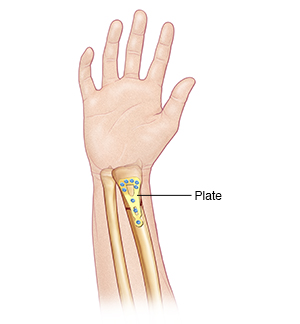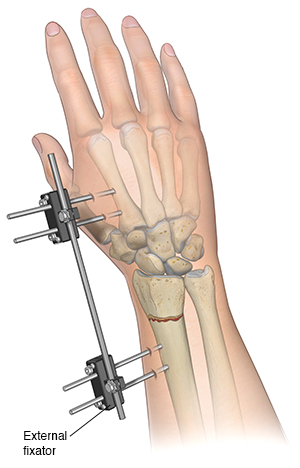Treating Wrist Fractures
A fractured bone starts to heal on its own right away. But a treatment called reduction may help you heal better. Reduction is a process that repositions your bones. The goal is to get them as close as possible to how they were before the break. Your healthcare provider will use one or more methods of reduction.
Closed reduction
If you have a clean break with little soft tissue damage that does not involve the joint, a closed reduction will likely be used. Before the procedure, you may be given medicine to numb the area and relax your muscles. Then your healthcare provider manually readjusts the position of the broken bone. A splint or cast will be worn while you heal.
Open reduction
 |
| A plate with tiny screws helps keep the bone stable and in place. |
Open reduction with internal fixation is a surgical procedure that may be used in cases of badly misaligned or unstable fractures, fractures involving one of the joints in the hand, or open fractures. An open fracture is one in which the skin is disrupted over a fracture, either because the bone has poked through the skin, or there is a wound over a fracture. You may be given medicine during the procedure to let you sleep and relax your muscles. Or you may have local or regional anesthesia to numb the area involved. Your healthcare provider then makes one or more cuts (incisions) to realign the bone and fix soft tissues. Pins, screws, plates, or a combination of implants may be used under the skin to hold the bone in place during healing. Another device that may be used is an external fixator. It holds the bones in the right position. It's surgically placed on the outside of the skin. It is removed or replaced with internal fixation as the injury heals.
 |
| An external fixator is a rigid bar that screws into the bone through tiny holes made in the skin. It holds the broken parts of bone in place. |
The road to healing
Fractures take about 6 weeks or more to heal. But it can take a year for full recovery. Keeping your hand raised above your heart can help control swelling, throbbing, and pain. Your healthcare provider may give you medicine to help ease pain. Don’t remove a splint unless your healthcare provider says you can. Call your healthcare provider if your pain gets worse or if you notice a lot of swelling or redness. Sometimes these implants, especially wires and external fixators, may need to be removed after the broken bone has healed.